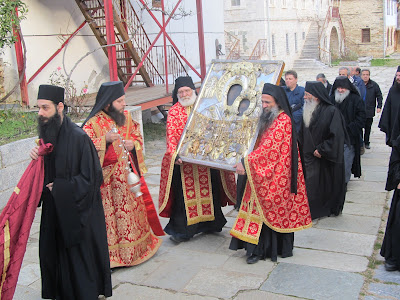The below text gives us a brief account of St. John Koukouzelis's life and why the Icon of The Theotokos, has the name Koukouzelissa.
Panagia Koukouzelissa is a miraculous Icon, which is located at the Holy Monastery of Great Lavra, the oldest and first in hierarchial order of all Monasteries on Mount Athos.
Its name comes from Saint John Koukouzelis, the renowned chanter of the Holy Monastery of Great Lavra.
The young John was born in 12th century in Dirrachio and his father passed away when he was very young. John and his pious mother lived in poverty, eating broad beans and peas almost on a daily basis. This is where John receives his nickname “Koukouzelis”. Broad beans in Greek is “koukia” and peas is “bizelia.” A synthesis of the two words: Koukouzelis.
When John came of age he went to Constantinople and enrolled himself into the Imperial Academy. Thanks to his beautiful voice, the Emperor Komninos soon noticed him. Not much time passed and he was made the head singer/musician of the imperial court. Although he had all of the worldly riches, his heart desired a life of silence, prayer and solitude. He was made aware that the Emperor sought to marry him to a lady of the court, and this resulted in his departure from Constantinople.
He had heard of Mount Athos and had decided to go there. Prior to his departure from Constantinople, he met the Abbot of Great Lavra whom he confessed his thoughts to. Afraid of the repercussions of leaving the Emperor, he disappeared. After some time had passed he arrived at Mount Athos, as an anonymous person, and went to the gate of the Great Lavra Monastery.
He begged the doorkeeper to let him in and allow him to be tonsured a monk. He was accepted and given the task of Sheppard of the Monastery’s animals thus achieving his desire for solitude and silence whilst maintaining his anonymity.
All of John’s desires had been fulfilled; he was in an environment filled with silence, peace and solitude. He was so very grateful to God for allowing his wishes to be granted to him. He chanted hymns with all of his heart and with such a spiritual sweetness, that he would draw the undivided attention of the horses in the flock he was minding, to an extent, that the animals would lose interest in eating or drinking, in order not to miss any of John’s chanting.
One day a hermit heard John’s beautiful chanting and saw the way the animals were so enthralled by the sound of his voice. The hermit immediately notified the Abbot of Great Lavra. John was summoned before the Abbot, however the Abbot barely recognized John whom he had once met, John’s features had changed from the thousands of prostrations and unceasing fasting and ascesis.
From that day onwards, the Abbot instructed John to stay in the nearby kellion of the Archangels for 6 days of the week and on Sundays, he would come to the Monastery and chant at the right hand analogion.
On the Saturday of the Akathist Hymn, whilst he chanted the Hymns of the feast, he sat for a while during the course of the all night vigil, at a seat opposite the Icon of Panagia The Most Holy Theotokos, in front of which the odes of the salutations are read.
As the vigil progressed, he heard a voice that said to him: “Salutations John!” and hearing the voice he opened his eyes and before him was The Theotokos which was Shining with the brightest heavenly light. She said to him “Chant for me, and I will not leave you.” With these words The Theotokos placed a gold coin in his hand, and disappeared.
John, who was overwhelmed with happiness and jubilation, fell to his knees, venerated the Icon of The Theotokos before him and thanked Her for Her love toward him and begged Her for his salvation.
He later hung the gold coin on the Icon of the Theotokos, which continued to be the source of numerous other miracles. From this point on, the Icon of The Theotokos was named Koukouzelissa.
From this point onwards, John conducted his chanting duties with much more enthusiasm, chanting with much piety and devotion for countless hours on his feet, without ever sitting. This practice took its toll on John’s feet, which formed open wounds and caused unbearable pain. Again though, The Holy Theotokos appeared to him and said: “From this moment on you will be healthy.” From that moment on, all of his wounds and sores disappeared.
After this miracle, John intensified his monastic program with stricter fasts, and increased prayer and was blessed with the ability to foresee his death. He asked the Abbot to bury him in the Chapel of his beloved kellion of The Archangels, and whilst praying, his soul departed for the Lord which he had loved all of his life and praised with his beautiful voice.
May God remember him for the ages to come, Amen.
The Holy Synod of Constantinople some years after his repose proclaimed John a Saint.
Saint John Koukouzelis also wrote music for many of the hymns in the Orthodox Church, in the Byzantine tradition. These works exist to this day, and are very commonly used on Mount Athos. The Chapel of Panagia Koukouzelissa - Holy Monastery of Great Lavra, Mount Athos. The Miraculous Icon is housed inside this chapel.
A procession of the Holy Icon.
Photo Sources:
agioritikesmnimes.blogspot.com
Orthodox Wiki
dimitrelos.gr
vatopaidi.wordpress.com










No comments:
Post a Comment